Paleoproterozoic Variolitic Lavas from the Onega Basin, Fennoscandian Shield: Mineralogy, Geochemistry and Origin
Abstract
:1. Introduction
2. Materials and Methods
2.1. Geological Settings
2.2. Methods
3. Results
3.1. Field Study
3.2. Petrography and Mineral Chemistry
3.2.1. VZ-Type
3.2.2. VU-Type
3.2.3. S-Type
3.3. Variolite Rock Chemistry
4. Discussion
4.1. Variolite Types
4.2. Origin of Variolites
4.3. Liquid Immiscibility vs. Undercooling
5. Conclusions
Supplementary Materials
Author Contributions
Funding
Data Availability Statement
Acknowledgments
Conflicts of Interest
References
- Appel, P.W.U.; Polat, A.; Frei, R. Dacitic Ocelli in Mafic Lavas, 3.8–3.7 Ga Isua Greenstone Belt, West Greenland: Geochemical Evidence for Partial Melting of Oceanic Crust and Magma Mixing. Chem. Geol. 2009, 258, 105–124. [Google Scholar] [CrossRef]
- Krassivskaya, I.S.; Sharkov, E.V.; Bortnikov, N.S.; Chistyakov, A.V.; Trubkin, N.V.; Golovanova, T.I. Variolitic Lavas in the Axial Rift of the Mid-Atlantic Ridge and Their Origin (Sierra Leone Area, 6°18′ N). Petrology 2010, 18, 263–277. [Google Scholar] [CrossRef]
- Philpotts, A.R. Archaean variolites—Quenched immiscible liquids: Discussion. Can. J. Earth. Sci. 1977, 14, 139–144. [Google Scholar] [CrossRef]
- Fergusson, J. Silicate Immiscibility in the Ancient Basalts of the Barberton Mountain Land, Traansvaal. Nat. Phys. Sci. 1972, 235, 86–89. [Google Scholar] [CrossRef]
- Cawthorn, R.G.; Mciver, J.R.; McCarthy, T.S.; Wyatt, B.A.; Ferguson, J.; Barnes, S.J. Possible liquid immiscibility textures in high magnesia basalts from the Ventersdorp Supergroup, South Africa. J. Geol. 1979, 87, 105–113. [Google Scholar] [CrossRef]
- Coltorti, M.; Giradi, V.A.; Schorscher, J.H.D. Liquid immiscibility in the Archean greenstone belt of Piumhi (Minais Gerais, Brazil). Lithos 1987, 20, 77–91. [Google Scholar] [CrossRef]
- Murphy, D.T.; Wiemer, D.; Bennett, V.C.; Spring, T.; Trofimovs, J.E.; Cathey, H.E. Paleoarchean variole-bearing metabasalts from the East Pilbara Terrane formed by hydrous fluid phase exsolution and implications for Archean greenstone belt magmatic processes. Precambrian Res. 2021, 357, 106–114. [Google Scholar] [CrossRef]
- Arndt, N.; Fowler, A.D. Textures in Komatiites and Variolitic Basalts. In The Precambrian Earth: Tempos and Events; Eriksson, P.G., Altermann, W., Nelson, D.R., Mueller, W.U., Catuneanu, O., Eds.; Elsevier: Amsterdam, The Netherlands, 2004; pp. 298–311. [Google Scholar]
- Sandsta, N.R.; Robins, B.; Furnes, H.; de Wit, M. The Origin of Large Varioles in Flow Banded Pillow Lava from the Hooggenoeg Complex, Barberton Greenstone Belt, South Africa. Contrib. Mineral. Petrol. 2011, 162, 365–377. [Google Scholar] [CrossRef]
- Hanski, E.J. Globular Ferropicritic Rocks at Pechenga, Kola Peninsula (Russia): Liquid Immiscibility Versus Alteration. Lithos 1993, 29, 197–216. [Google Scholar] [CrossRef]
- Polat, A.; Frei, R.; Fryer, B.; Appel, P.W. The origin of geochemical trends and Eoarchean (ca. 3700 Ma) zircons in Mesoarchean (ca. 3075 Ma) ocelli-hosting pillow basalts, Ivisaartoq greenstone belt, SW Greenland: Evidence for crustal contamination versus crustal recycling. Chem. Geol. 2009, 268, 248–271. [Google Scholar]
- Gélinas, L.; Brooks, C.; Trzcienski, W., Jr. Archean variolites— quenched immiscible liquids. Can. J. Earth Sci. 1976, 13, 210–230. [Google Scholar] [CrossRef]
- Fowler, A.D.; Jensen, L.S.; Peloquin, S.A. Varioles in Archean basalts: Products of spherulitic crystallization. Can. Mineral. 1986, 25, 275–289. [Google Scholar]
- Fowler, A.D.; Berger, B.; Shore, M.; Jones, M.I.; Ropchan, J.R. Supercooled rocks: Development and significance of varioles, spherulites, dendrites and spinifex in Archean volcanic rocks, Abitibi Greenstone Belt, Canada. Precambrian Res. 2002, 115, 311–328. [Google Scholar] [CrossRef]
- Svetov, S.A.; Svetova, A.I.; Huhma, H. Geochemistry of the komatiite- tholeiite rock association in the Vedlozero-Segozero Archean greenstone belt, Central Karelia. Geochem. Int. 2001, 39, 24–38. [Google Scholar]
- Hickman, A.H. Review of the Pilbara Craton and Fortescue Basin, Western Australia: Crustal evolution providing environments for early life. Isl. Arc 2012, 21, 1–31. [Google Scholar] [CrossRef]
- Levinson-Lessing, F.Y. Selected Manuscripts; AN SSSR: Moscow, Russia, 1949; pp. 38–54. [Google Scholar]
- Pugin, V.A.; Khitarov, N.E. Geochemistry of some elements under the basalt magmatic liquation. Geokhimiya 1982, 1, 35–46. [Google Scholar]
- Svetov, S.A. Liquation Differentiation in Basaltic Systems as Exemplified by the Suisarian Variolites of the Yalguba Range. Geol. Ore Depos. Karelia 2008, 11, 120–134. [Google Scholar]
- Kulikov, V.S.; Rychanchik, D.V.; Golubev, A.I.; Filippov, M.M.; Tarkhanov, G.V.; Frik, M.G.; Svetov, S.A.; Kulikova, V.V.; Sokolov, S.Y.; Romashkin, A.E. Stratigraphy and magmatism. Ludicovian. In Paleoproterozoic Onega Structure: Geology, Tectonics, Structure, and Metallogeny; Glushanin, L.V., Sharov, N.V., Shchiptsov, V.V., Eds.; Karelian Research Centre, RAS: Petrozavodsk, Russia, 2011; pp. 67–101. (In Russian) [Google Scholar]
- Gudin, A.N.; Dubinina, E.O.; Nosova, A.A. Petrogenesis of Variolitic Lavas of the Onega Structure, Central Karelia. Petrology 2012, 20, 255–270. [Google Scholar] [CrossRef]
- Svetov, S.A.; Chazhengina, S.Y. Geological Phenomenon of Yalguba Ridge Variolite from F. Yu. Levinson-Lessing’s Time until Today: Mineralogical and Geochemical Aspects. Geol. Ore Depos. 2018, 60, 547–558. [Google Scholar] [CrossRef]
- Pugin, V.A.; Hitarov, N.E. Variolites as an example of the magmatic liquation. Geochemistry 1980, 4, 496–512. [Google Scholar]
- Melezhik, V.A.; Hanski, E.J. The Pechenga Greenstone Belt. In Reading the Archive of Earth’s Oxygenation; Melezhik, V.A., Prave, A.R., Fallick, A.E., Kump, L.R., Strauss, H., Lepland, A., Hanski, E.J., Eds.; Springer: Berlin/Heidelberg, Germany, 2013; pp. 289–385. [Google Scholar]
- Kulikov, V.S.; Svetov, S.A.; Slabunov, A.I.; Kulikova, V.V.; Polin, A.K.; Golubev, A.I.; Gorkovets, V.Y.; Ivashchenko, V.I.; Gogolev, M.A. Geological map of Southeastern Fennoscandia (scale 1:750,000): A new approach to map compilation. Trans. KarRC RAS 2017, 2, 3–41. [Google Scholar] [CrossRef]
- Slabunov, A.I.; Lobach-Zhuchenko, S.B.; Bibikova, E.V.; Sorjonen-Ward, P.; Balagansky, V.V.; Volodichev, O.I.; Shchipansky, A.A.; Svetov, S.A.; Chekulaev, V.P.; Arestova, N.A.; et al. The Archaean nucleus of the Fennoscandian (Baltic) Shield. In European Lithosphere Dynamics; Gee, D.G., Stephenson, R.A., Eds.; Memoirs, No. 32; Geological Society: London, UK, 2006; pp. 627–644. [Google Scholar]
- Kulikov, V.S.; Kulikova, V.V.; Lavrov, B.S.; Pisarevskii, S.A.; Pukhtel, I.S.; Sokolov, S.Y. The Paleoroterozoic Suisarian Picrite–Basalt Complex. In Karelia: Key Section and Petrology; KNTs RAN: Petrozavodsk, Russia, 1999; pp. 34–58. [Google Scholar]
- Leonov, M.G.; Kulikov, V.S.; Zykov, D.S.; Kolodyazhny, S.Y.; Poleshchuk, A.V. Tectonics. In Paleoproterozoic Onega Structure: Geology, Tectonics, Structure, and Metallogeny; Glushanin, L.V., Sharov, N.V., Shchiptsov, V.V., Eds.; Karelian Research Centre, RAS: Petrozavodsk, Russia, 2011; pp. 127–170. [Google Scholar]
- Hanski, E.J. 3.4 Evolution of the Palaeoproterozoic (2.50–1.95 Ga) Non- orogenic Magmatism in the Eastern Part of the Fennoscandian Shield. In Reading the Archive of Earth’s Oxygenation; Melezhik, V.A., Prave, A.R., Fallick, A.E., Kump, L.R., Strauss, H., Lepland, A., Hanski, E.J., Eds.; Springer: Berlin/Heidelberg, Germany, 2013; pp. 179–245. [Google Scholar]
- Puchtel, I.S.; Arndt, N.T.; Hofmann, A.W.; Haase, K.M.; Kröner, A.; Kulikov, V.S.; Kulikova, V.V.; Garbe-Schönberg, C.D.; Nemchin, A.A. Petrology of mafic lavas within the Onega plateau, central Karelia: Evidence for 2.0 Ga plume-related continental crustal growth in the Baltic Shield. Contrib. Mineral. Petrol. 1998, 130, 134–153. [Google Scholar] [CrossRef]
- Stepanova, A.V.; Samsonov, A.V.; Larionov, A.N. The final episode of the Mid-Paleoproterozoic magmatism in the Onega Basin: Data on dolerites in Zaonezhski peninsula. Pros. Karel. Res. Cent. Ras 2014, 1, 3–16. [Google Scholar]
- Svetov, S.A. Paleoproterozoic Platform Basalt Volcanism in Karelia; Nauka: Leningrad, Russia, 1979; pp. 173–179. [Google Scholar]
- Glebovitskii, V.A.; Bushmin, S.A.; Belyatsky, B.V.; Bogomolov, E.S.; Borozdin, A.P.; Savva, E.V.; Lebedeva, Y.M. RB-SR age of metasomatism and ore formation in the low-temperature shear zones of the Fenno-Karelian Craton, Baltic Shield. Petrology 2014, 22, 184–204. [Google Scholar] [CrossRef]
- Spiridonov, E.M.; Putintzeva, E.V.; Lavrov, O.B.; Ladygin, V.M. Kronstedtite, pumpelliite, prehnite and lennilenapeite in the metaagates and metabasalts of the early Proterozoic trap formation in the northern Onega region. In Proceedings of the Conference Lomonosov Readings, Moscow, Russia, 17–27 April 2017; Moscow State University: Moscow, Russia, 2017. Available online: https://conf.msu.ru/file/event/4305/eid4305_attach_b0acc3e7de2cd859225469534617a6272d70ce50.pdf (accessed on 9 July 2021).
- Svetov, S.A.; Stepanova, A.V.; Chazhengina, S.Y.; Svetova, E.N.; Rybnikova, Z.P.; Mikhailova, A.I.; Paramonov, A.S.; Utitsyna, V.L.; Ekhova, M.V.; Kolodey, B.S. Precision geochemical (ICP-MS, LA-ICP-MS) analysis of rock and mineral composition: The method and accuracy estimation in the case study of early Precambrian mafic complexes. Writ. Karelian Res. Cent. Russ. Acad. Sci. 2015, 7, 54–73. [Google Scholar]
- Sun, S.; McDonough, W.F. Chemical and isotopic systematics of oceanic basalts: Implications for mantle composition and processes. Geol. Soc. Spec. Publ. 1989, 42, 313–345. [Google Scholar] [CrossRef]
- Svetov, S.A.; Chazhengina, S.Y.; Stepanova, A.V. Geochemistry and texture of clinopyroxene phenocrysts from Paleoproterozoic picrobasalts, Onega Basin, Fennoscandian Shield: Records of magma mixing processes. Minerals 2020, 10, 434. [Google Scholar] [CrossRef]
- Longfren, G. An experimental study of plagioclase crystal morphology: Isothermal crystallization. Am. J. Sci. 1974, 274, 243–273. [Google Scholar]
- Parsons, I. Feldspars defined and described: A pair of posters published by the Mineralogical Society. Sources and supporting information. Mineral. Mag. 2010, 3, 529–551. [Google Scholar] [CrossRef]
- Wen, S.; Nekvasil, H. Solvcalc: An interactive graphics program package for calculating the ternary feldspar solvus and for two-feldspar geothermometry. Comput. Geosci. 1994, 20, 1025–1040. [Google Scholar] [CrossRef]
- Deer, W.A.; Howie, R.A.; Zussman, J. Rock-Forming Minerals. Framework Silicates. Feldspar, 2nd ed.; Geological Society: London, UK, 2001; pp. 117–139. [Google Scholar]
- Schmidt, M.W.; Connolly, J.A.D.; Günther, D.; Bogaerts, M. Element partitioning: The role of melt structure and composition. Science 2006, 312, 1646–1650. [Google Scholar] [CrossRef] [PubMed]
- Veksler, I.V. Liquid immiscibility and its role at the magmatic-hydrothermal transition: A summary of experimental studies. Chem. Geol. 2004, 210, 7–31. [Google Scholar] [CrossRef]
- Veksler, I.V.; Dorfman, A.M.; Danyushevsky, L.V.; Jakobsen, J.K.; Dingwell, D.B. Immiscible silicate liquid partition coefficients: Implications for crystal-melt element portioning and basalt petrogenesis. Contrib. Mineral. Petrol. 2006, 152, 685–702. [Google Scholar] [CrossRef]
- Thompson, A.B.; Aerts, M.; Hack, A.C. Liquid immiscibility in silicate melts and related systems. Rev. Mineral. Geochem. 2007, 65, 99–127. [Google Scholar] [CrossRef]
- Longfren, G. Spherulitic textures in glassy and crystalline rocks. J. Geophys. Res. 1971, 76, 5635–5648. [Google Scholar]
- Lofgren, G. Experimentally Produced Devitrification Textures in Natural Rhyolitic Glass. Geol. Soc. Am. Bul. 1971, 82, 111–124. [Google Scholar] [CrossRef]
- Dinel, E.; Saumur, B.M.; Fowler, A.D. Spherulitic Aphyric Pillow-Lobe Metatholeiitic Dacite Lava of the Timmins Area, Ontario, Canada: A New Archean Facies Formed from Superheated Melts. Econ. Geol. 2008, 103, 1365–1378. [Google Scholar] [CrossRef]
- Fonseca, R.O.C.; Michely, L.T.; Kirchenbaur, M.; Prytulak, J.; Ryan, J.; Hauke, K.; Leitzke, F.P.; Almeev, R.R.; Marien, C.S.; Gerdes, A.; et al. Formation mechanisms of macroscopic globules in andesitic glasses from the Izu–Bonin–Mariana forearc (IODP Expedition 352). Contrib. Mineral. Petrol. 2021, 176, 2. [Google Scholar] [CrossRef]
- Giuliania, L.; Iezzia, G.; Veterec, F.; Behrensd, H.; Mollo, S.; Cautia, F.; Ventura, G.; Scarlato, P. Evolution of textures, crystal size distributions and growth rates of plagioclase, clinopyroxene and spinel crystallized at variable cooling rates from a mid-ocean ridge basaltic melt. Earth Sci. Rev. 2020, 204, 103165. [Google Scholar] [CrossRef]
- Ballhaus, C.; Fonseca, R.O.C.; Munker, C.; Kirchenbaur, M.; Zirner, A. Spheroidal textures in igneous rocks–Textural consequences of H2O saturation in basaltic melts. Geochim. Cosmochim. Acta 2015, 167, 241–252. [Google Scholar] [CrossRef]
- Burkhard, D. Nucleation and growth rates of pyroxene, plagioclase, and Fe-Ti oxides in basalt under atmospheric conditions. Eur. J. Mineral. 2005, 17, 675–685. [Google Scholar] [CrossRef]
- Condie, K. Changing tectonic settings through time: Indiscriminate use of geochemical discriminant diagrams. Precambrian Res. 2015, 266, 587–591. [Google Scholar] [CrossRef]
- Rudnick, R.L.; Gao, S. Composition of the continental crust. In Treatise on Geochemistry; Rudnick, R.L., Ed.; Elsevier: Oxford, UK, 2003; Volume 4, pp. 1–64. [Google Scholar]
- Krupenik, V.A.; Akhmedov, A.M.; Sveshnikova, K.Y. Structure of the Onega sequence based on Onega parametric borehole. In Paleoproterozoic Onega Structure: Geology, Tectonics, Structure, and Metallogeny; Glushanin, L.V., Sharov, N.V., Shchiptsov, V.V., Eds.; Karelian Research Centre, RAS: Petrozavodsk, Russia, 2011; pp. 171–176. [Google Scholar]
- Luque, F.J.; Huizenga, J.-M.; Crespo-Feo, E.; Ortega, L.; Barrenechea, J.F. Vein graphite deposits: Geological settings, origin, and economic significance. Miner. Depos. 2014, 49, 261–277. [Google Scholar] [CrossRef]
- Melezhik, V.A.; Fallick, A.E.; Filippov, M.M.; Lepland, A.; Rychanchik, D.V.; Deines, Y.E.; Medvedev, P.V.; Romashkin, A.E.; Strauss, H. Petroleum surface oil seeps from a Paleoproterozoic petrified giant oilfield. Terra Nova 2009, 21, 119–126. [Google Scholar] [CrossRef]
- Elkins, L.T.; Grove, T.L. Ternary feldspar experiments and thermodynamic models. Am. Mineral. 1990, 75, 544–559. [Google Scholar]
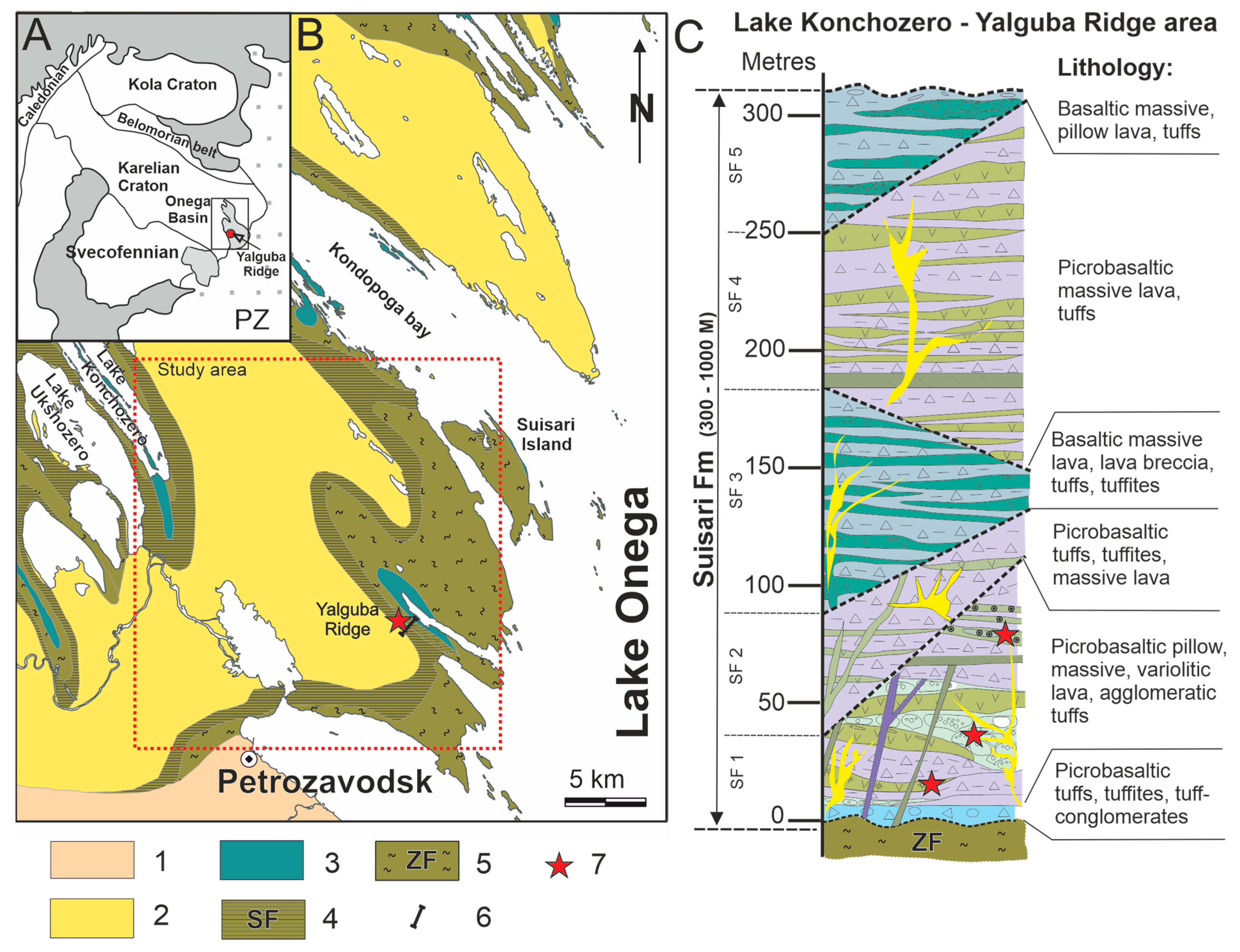
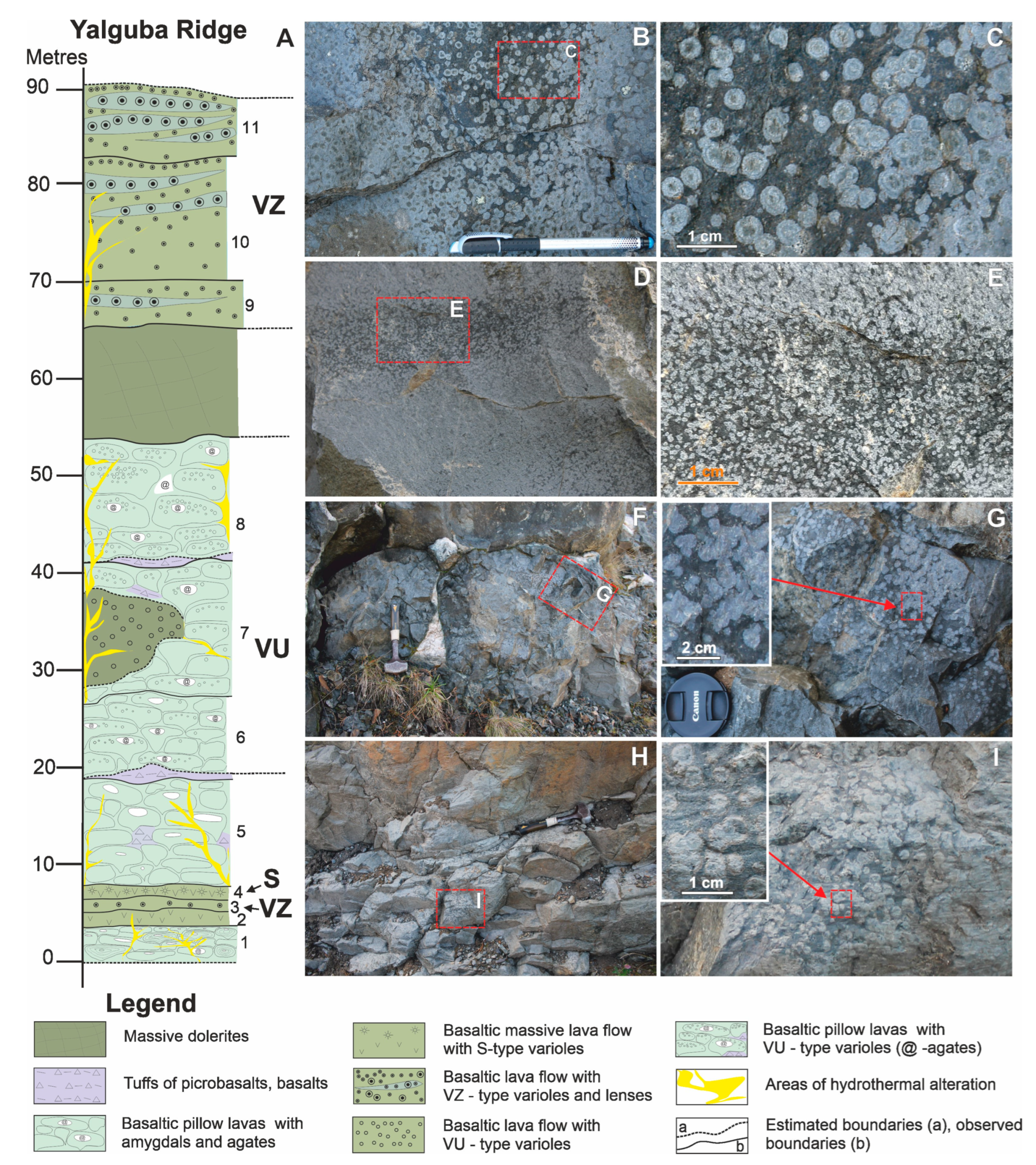
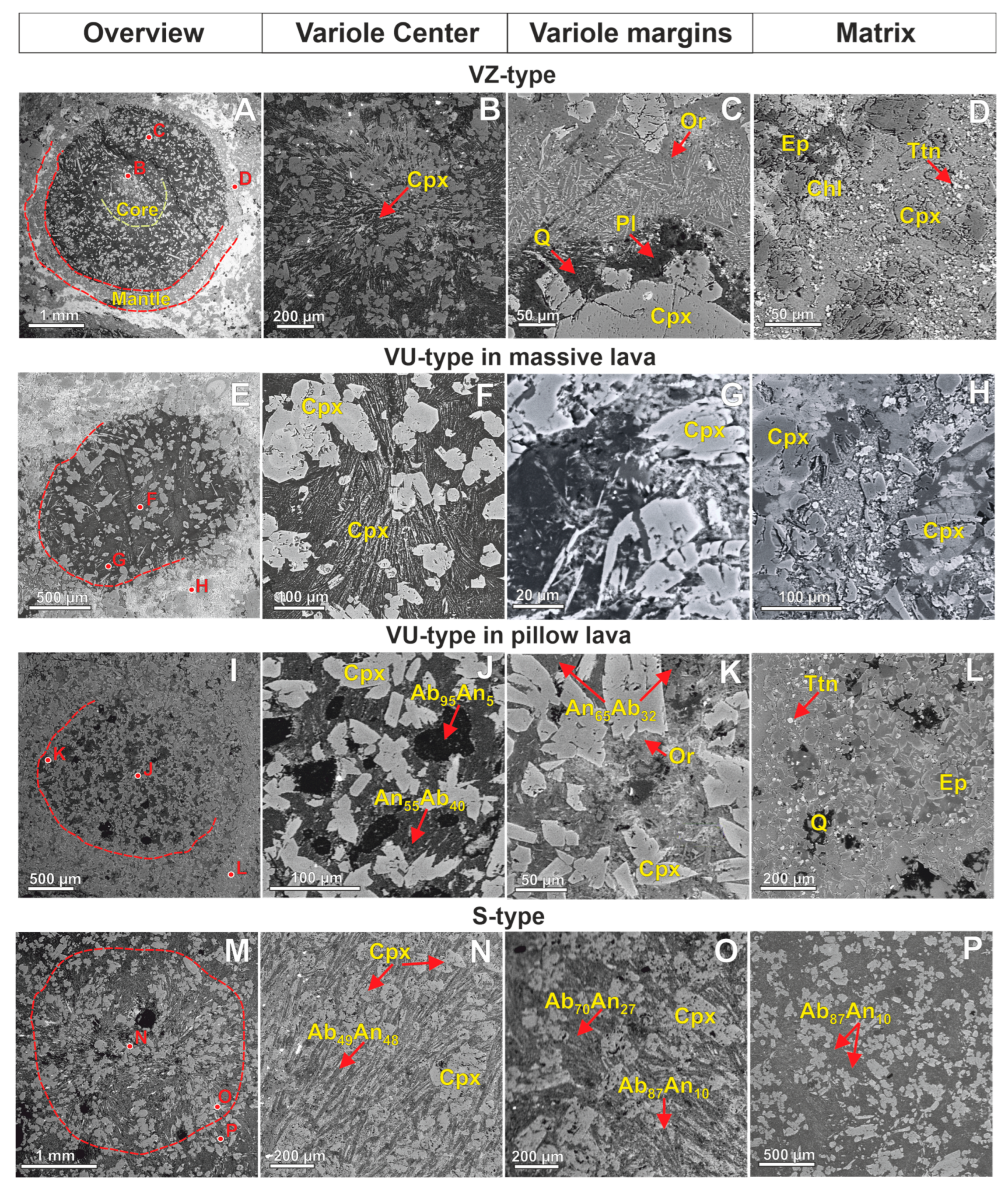
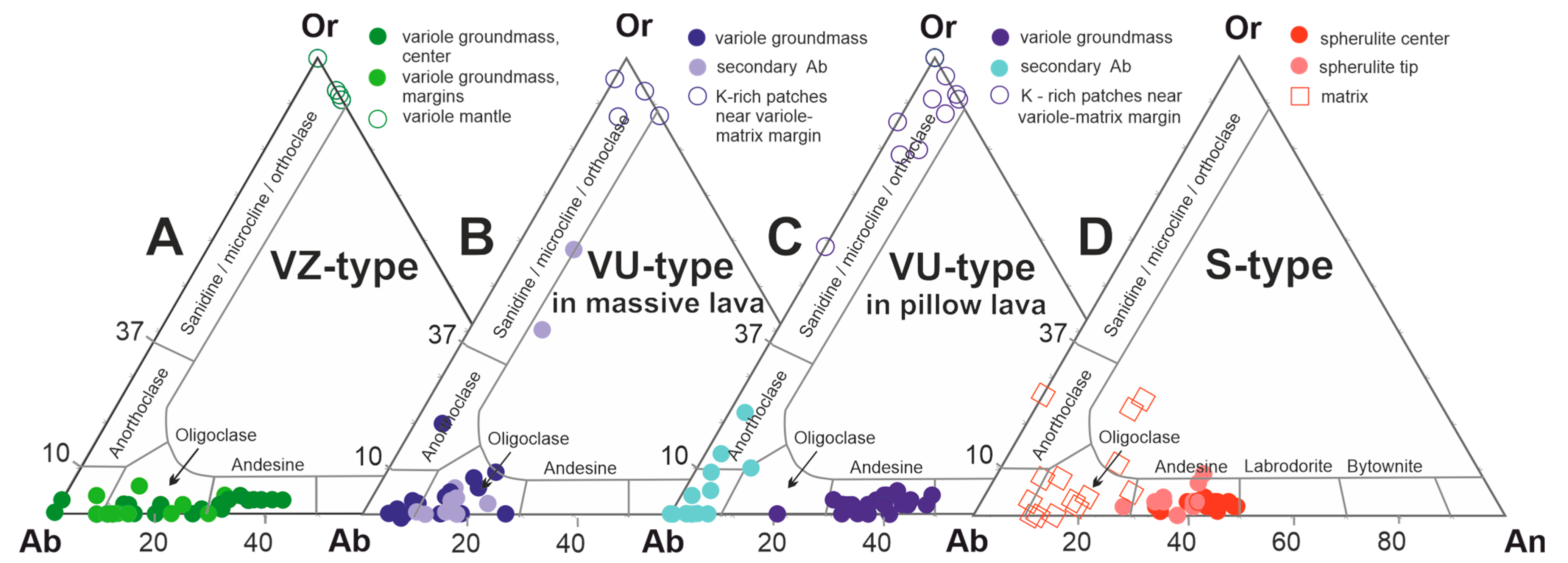
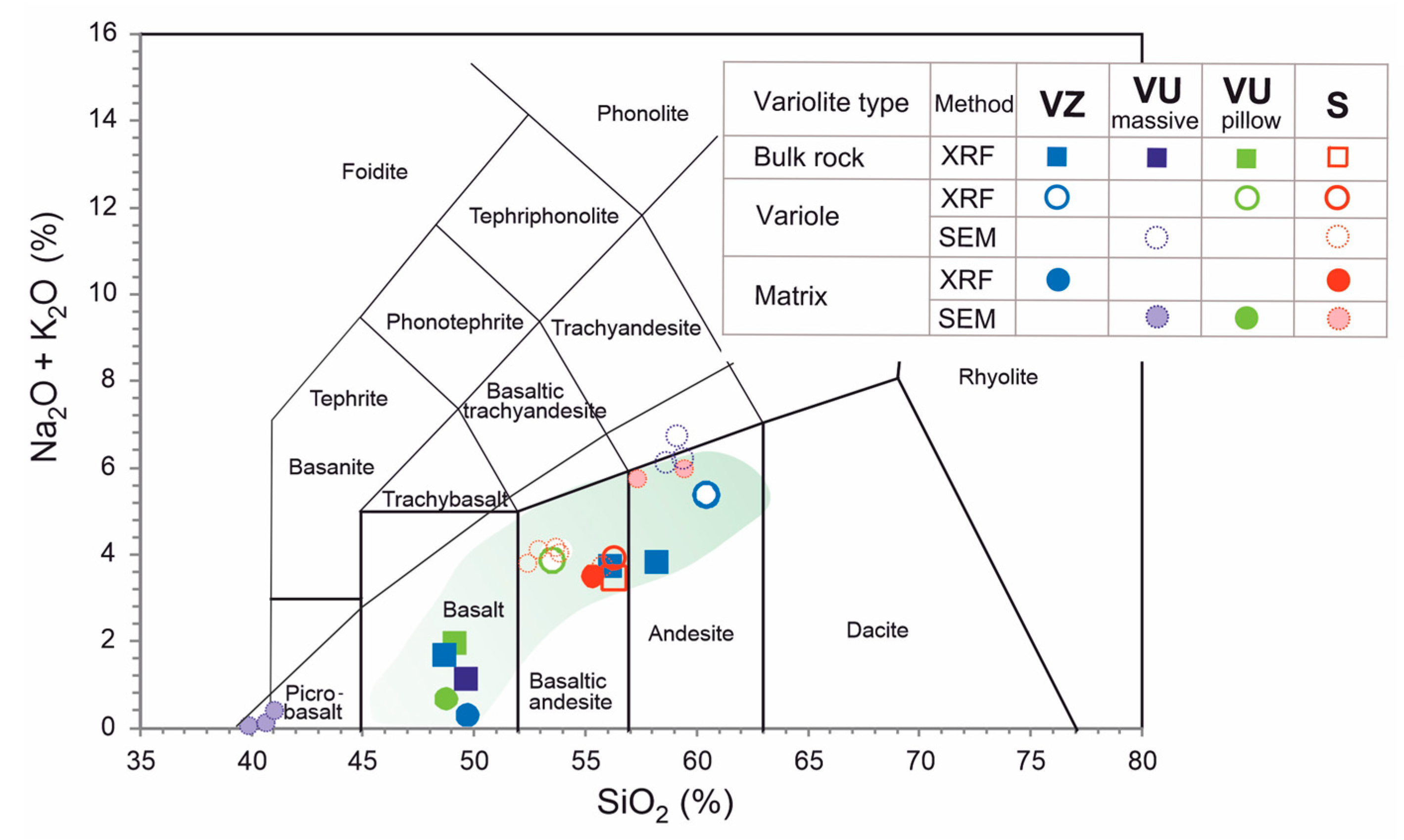
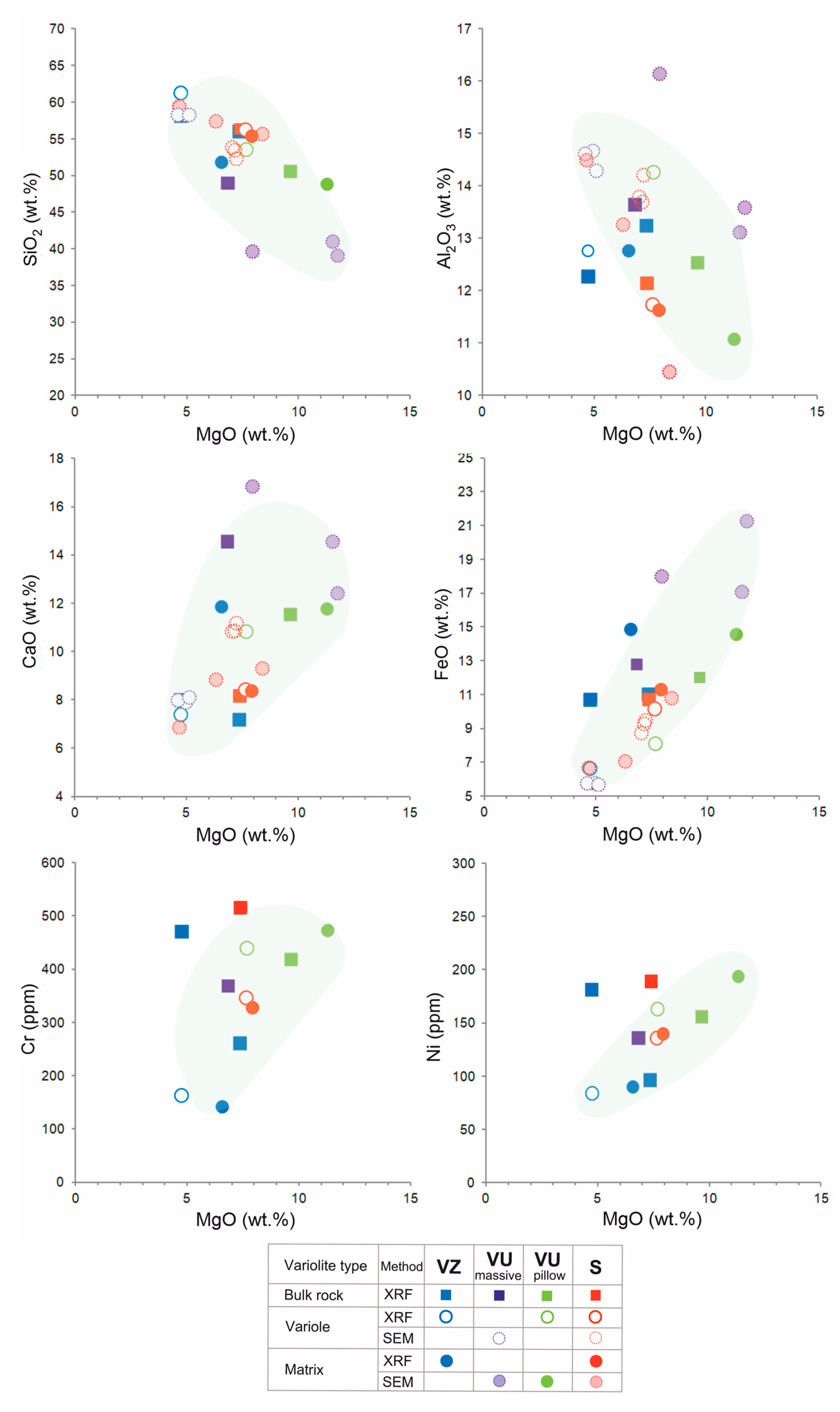
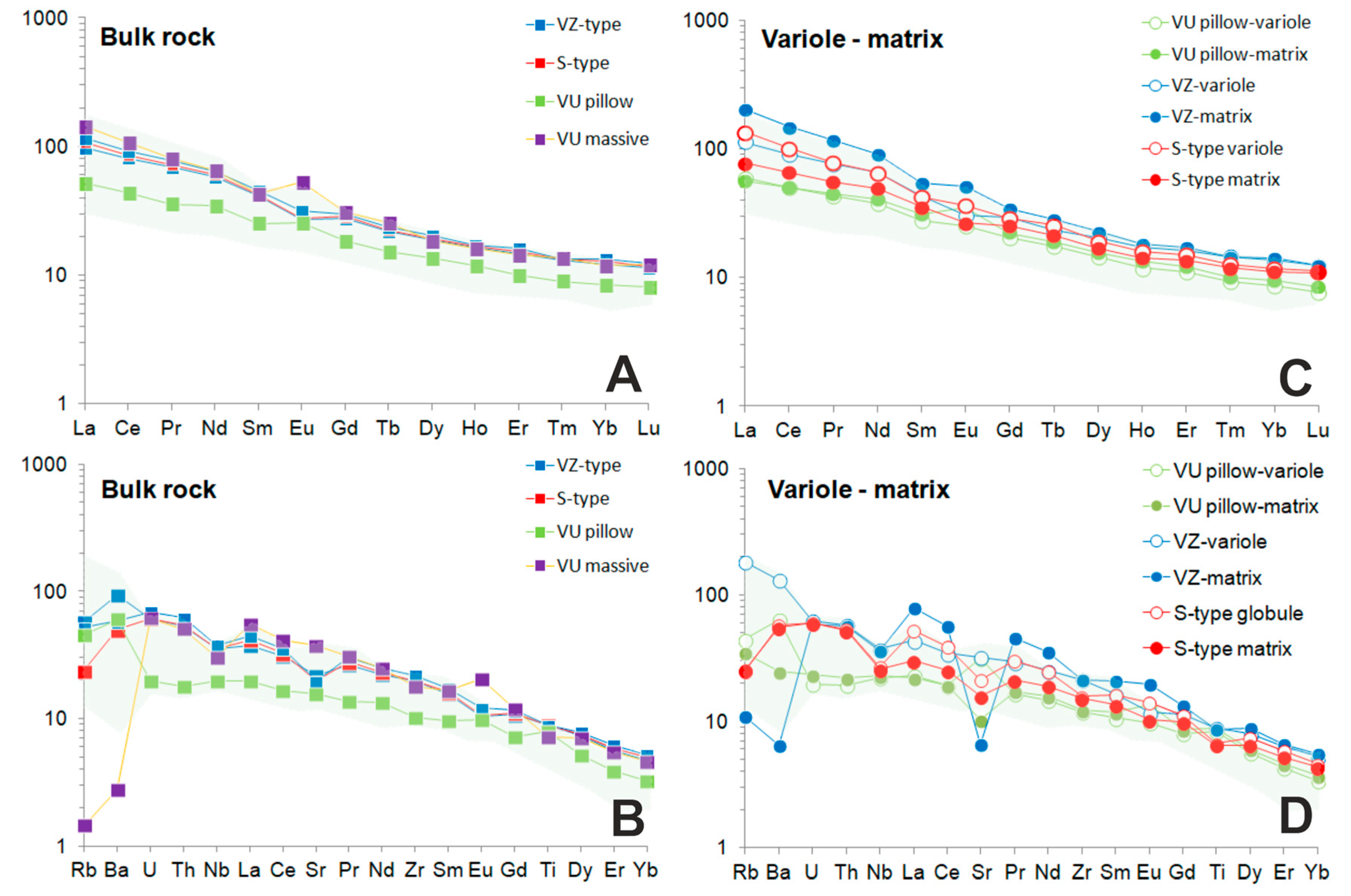
| Variolite Type | Variole Texture | Lava Flow | Rock | Mineral Composition | Origin | ||||
|---|---|---|---|---|---|---|---|---|---|
| Bulk | Variole | Matrix | Variole | Variole Rim | Matrix | ||||
| VZ | zoned | massive | basaltic andesite, andesite | andesite | basalt | Ab, Q, Cpx | K-Fsp | Q, Chl, Ep | liquid immiscibility |
| Cpx phenocrysts and microcrysts | |||||||||
| VU | unzoned | massive | basalt | andesite | picrobasalt | Pl, Ab, K-Fsp, Q, | absent | Q, Chl, Ep, glass relicts | liquid immiscibility |
| pillow | andesite | basalt | Cpx phenocrysts and microcrysts | ||||||
| S | spherulite | massive | basaltic andesite | basaltic andesite | andesite | Pl | absent | Pl, Q, Chl | undercooling |
| Cpx phenocrysts and microcrysts | |||||||||
Disclaimer/Publisher’s Note: The statements, opinions and data contained in all publications are solely those of the individual author(s) and contributor(s) and not of MDPI and/or the editor(s). MDPI and/or the editor(s) disclaim responsibility for any injury to people or property resulting from any ideas, methods, instructions or products referred to in the content. |
© 2023 by the authors. Licensee MDPI, Basel, Switzerland. This article is an open access article distributed under the terms and conditions of the Creative Commons Attribution (CC BY) license (https://creativecommons.org/licenses/by/4.0/).
Share and Cite
Svetov, S.A.; Chazhengina, S.Y.; Stepanova, A.V. Paleoproterozoic Variolitic Lavas from the Onega Basin, Fennoscandian Shield: Mineralogy, Geochemistry and Origin. Minerals 2023, 13, 1320. https://doi.org/10.3390/min13101320
Svetov SA, Chazhengina SY, Stepanova AV. Paleoproterozoic Variolitic Lavas from the Onega Basin, Fennoscandian Shield: Mineralogy, Geochemistry and Origin. Minerals. 2023; 13(10):1320. https://doi.org/10.3390/min13101320
Chicago/Turabian StyleSvetov, Sergei A., Svetlana Y. Chazhengina, and Alexandra V. Stepanova. 2023. "Paleoproterozoic Variolitic Lavas from the Onega Basin, Fennoscandian Shield: Mineralogy, Geochemistry and Origin" Minerals 13, no. 10: 1320. https://doi.org/10.3390/min13101320






